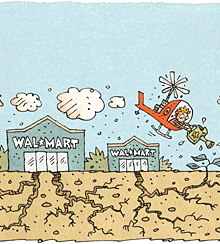Why Walmart is like a forest
Thinking about your company as an ecosystem yields lessons for innovation, growth, and renewal.
(originally published by Booz & Company)The story of Wal-Mart Stores Inc.’s growth from a chain of small, rural discount stores to its current position as the world’s largest retailer and private employer is the stuff of business legend. Analysts cite numerous reasons for the company’s growth, ranging from its logistical prowess and the entrepreneurial genius of founder Sam Walton to predatory pricing and the abuse of labor laws. But a cause of Walmart’s success that one rarely sees advanced is that of the firm’s roots in rural Arkansas, and the disciplines imposed on the fledgling business by that challenging context.
To understand this, it’s helpful to think of Walmart as an ecosystem, like a forest, and track the company’s growth from its small beginnings to large-scale maturity. In addition, the forest analogy gives us insight into the process of organizational renewal — a challenge that faces many corporations and institutions in the West.
The development of a forest, or forest succession, in a temperate climate begins in an open patch of land that provides equal access to sun and rain. Its initial colonizers are migrants — weeds and wandering animals that spread seeds. These colonizers are the entrepreneurs of the ecosystem. They are attracted by the ready availability of small-scale resources and the absence of competition, a combination that enables everything to grow like crazy.
You can see the same dynamics at work in Walmart’s early years. Entrepreneurial merchant Sam Walton perfected a way to make profits from small outlets in sparsely populated rural areas, which he often identified from the air. His first store was only 16,000 square feet; subsequent stores were even smaller, at 12,000 square feet.
Because of the absence of competition in small towns, Walmart grew like a weed. Walton, the wanderer, had a network of 24 stores in Arkansas before he moved into neighboring states, still pursuing a rural strategy and avoiding competition in denser population centers. This was in the 1960s, when the development of the suburban mall was well under way and many retailers, like Kmart and Sears, Roebuck and Company, were pursuing economies of scale. Sears at this time could probably not have made a decent return from stores much under 50,000 square feet, and suitable locations were hard to find and were packed with competitors.
In the forest, the weeds and wanderers thrive in the open patches until they start to bump into one another. This creates competition for resources, and favors shrubs and plants that develop efficient infrastructures. Their roots get to the water first, and the light gets to their branches and leaves first, helping them grow faster (which then stunts the growth of their competitors). In turn, the shrubs are succeeded by softwood trees, which are complex, hierarchical organisms that use resources even more efficiently.
It’s not hard to see the same progression at Walmart. Because traditional wholesalers refused to make small drop-offs on remote country routes, Walton was forced to develop his own distribution infrastructure. This was the genesis of the company’s famed logistics system, which was steadily refined as the constraints to efficient shipping were overcome by novel solutions such as cross-docking, in which goods delivered from suppliers are shipped directly to branches without intermediate warehousing. Walton’s continual innovations in infrastructure soon helped him bypass his competitors, and then prevented them from catching up.
Seeds of Destruction
In the idealized forest succession, softwood trees are supplanted by hardwood trees, which vie for resources using different strategies. In the mixed forests of the southeastern United States, for example, the longleaf pine gives way to the oak. The longleaf pine’s needles are designed to promote fire on the forest floor, because its seeds can germinate only on bare ground. The deciduous oak, however, sheds its leaves, which absorb and hold groundwater, damping any fire and creating a deep mold in which acorns can germinate. Once established, the oaks will outcompete the pines.
With the appearance of the hardwood trees, forest succession has reached its so-called climax phase. This used to be thought of as a state of equilibrium, but it is not. Reduction in the variety of organisms in the ecosystem leads inexorably to a lack of resilience in the face of change. Too many trees of the same species and similar age are vulnerable to the same challenges, such as wind, disease, and insect attack. The conditions are now right for a sudden catastrophe that will sweep away mature growth and open up the system for renewal.
As Walmart grew and encountered more competition, the size of its stores grew, too. By 2010, they had reached an average size of more than 160,000 square feet, a ninefold growth over 48 years — the hardwood trees in the Walmart ecology. With the twin advantages of innovation and scale, Walmart entered its climax phase.
Thus far, Walmart has largely avoided the vulnerability inherent in this phase by adapting and diversifying. Today Walmart’s stores fall into three broad segments. The first is the original discount stores, of which there are 803, averaging 108,000 square feet. Their numbers are declining as they are replaced by the second type of store, the supercenters, of which there are now 2,747, averaging 186,000 square feet. The third group is a recently added category of neighborhood stores, of which there are 158, averaging 42,000 square feet in area. Walmart locates these latter outlets in areas that cannot justify larger stores. Its profits from these small “shrubs” are probably modest, but their very presence takes away resources from would-be rivals, such as dollar stores, that are trying to start up in the same small-scale way that Walmart did, and that might otherwise disrupt the ecosystem in the same way that Walmart decimated Kmart and Sears.
But like the forest, retail stores can fall prey to systemic problems in the climax phase. As enterprises such as Walmart perfect their recipe for success, their means have a habit of running away with their ends. Senior management often forgets the founder’s original goals, which may have long since been realized. As Walmart’s recent problems with allegations of bribery in Mexico indicate, executives must continually revisit and renew their company’s mission and purpose. Otherwise the company can easily lose its sense of identity and, with that, its moral compass.
The Cycle Begins Anew
Applying an ecological perspective to business yields some interesting insights about how to achieve sustainable success.
• Don’t think of organizations just as structures; also think of them as movements. Organizations are conceived in passion and born in communities of trust. They grow through the application of reason and mature in power. Today Walmart looks like a huge monolithic structure, but it began life as a movement, fueled by the convictions of Sam Walton and his vision of service to a community.
• Realize that change is inevitable: The only real choice is whether you will seek to anticipate it or have it thrust upon you and be forced to respond without the benefit of forethought. Ecosystems need regular disruption to create the open patches necessary for renewal. The use of prescribed burns to renew forests and the release of spring “pulses” of water from dams to renew rivers are excellent examples of proactive interventions in the management of natural systems.
• Pursue change on the edges of systems and in open patches, where variety can flourish on a small scale and without competition. Know that, conversely, change in the core is difficult because there is fierce competition for resources.
• Remember that the fruits of success always contain the seeds of destruction: Success tends to perpetuate itself, leading to the growth of large, slow-moving systems and homogeneity, which then leads to a lack of resilience and vulnerability to catastrophic change.
• Creation requires destruction: Look for openings on disturbed ground — turbulent markets where information is scarce and navigation is unclear. What economists call market failures, entrepreneurs call opportunities.
The destructive close of a mature forest’s cycle demonstrates this last point. In the lodgepole pine forests of the Western mountain ranges in North America, fire ends the climax phase. The lodgepole is a self-pruner: As it ages, it drops its lower branches on the ground. Older trees also become vulnerable to attack by bugs, and are turned into standing firewood. As the fuel builds and the forest becomes more tightly connected, fire becomes inevitable, culminating in conflagrations like the massive Yellowstone fires of 1988.
But forests need fire. Fire tests the system and breaks down the tall hierarchies (old trees) that monopolize the resources, recycling them into nutrients. Indeed, fire marks the completion of one cycle for the forest. It creates the open patches that attract the entrepreneurs. It makes way for variety to reenter the system, both in the form of the seeds and weeds and in the creation of multi-aged stands of the dominant species. Such an ecosystem is once again loosely connected because resources can flow through it in many ways. It is no longer vulnerable to being wiped out by a single event, and the perpetual cycle of forest succession begins again.
The Western world, led by the United States, is going through a testing time. We often hear talk of “creative destruction,” but without an appreciation of how the process actually works. Our response to today’s challenges will determine whether we can renew ourselves and create a sustainable future or whether we will go into a long decline. We could do much worse than to take our cues to action from nature itself. ![]()
Reprint No. 00120
Author profile:
- David K. Hurst is an adjunct professor at the University of Regina’s Graduate School of Business and a contributing editor of strategy+business.
- This article is adapted from Hurst’s latest book, The New Ecology of Leadership: Business Mastery in a Chaotic World (Columbia University Press, 2012).




